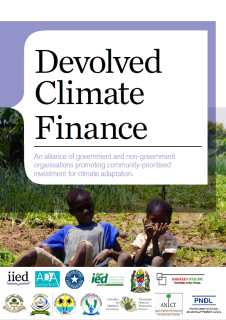
Developed countries have committed to making sure US$100 billion of funds flows to developing countries by 2020 to respond to the effects of climate change. Several avenues exist to channel funds for climate change adaptation, but once in country, money must flow further to sub-national governments and communities that need it most.
This brief showcases a climate finance and planning mechanism designed by an alliance of government and nongovernment organisations in Kenya, Tanzania, Mali and Senegal that aims to make the most of the funding from developed countries for climate change adaptation. The alliance has establishes institutions to help communities identify and oversee resilience-building investments and use bespoke planning tools that incorporate valuable local knowledge and recognise the different ways climate change affects women, men and marginalised groups. The mechanism draws on climate information services to enhance planning and on monitoring and evaluation methods to support learning along the way.
